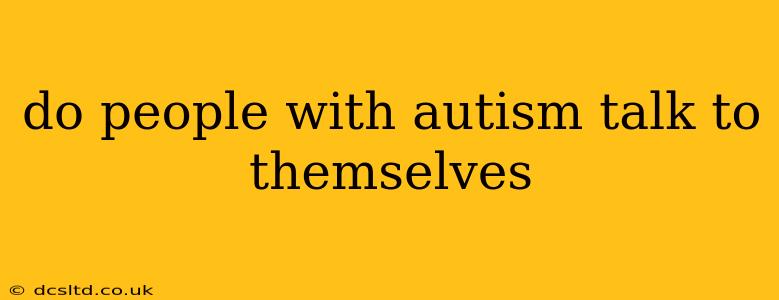Do People with Autism Talk to Themselves? Understanding Self-Talk in Autism
Many people wonder if individuals with autism spectrum disorder (ASD) talk to themselves more than neurotypical individuals. The short answer is: it's complicated, and there's no simple yes or no. While some individuals with autism may engage in self-talk more frequently or visibly, it's not a defining characteristic of the condition. Let's delve into the nuances of this question.
What is Self-Talk?
Before addressing autism, it's important to understand self-talk in general. Self-talk encompasses the internal monologue we all experience – the thoughts, comments, and instructions we give ourselves. This can range from quiet internal reflections to audible muttering. Everyone engages in self-talk to varying degrees, serving various purposes like problem-solving, self-regulation, and rehearsal.
Self-Talk in Individuals with Autism: A Spectrum of Experiences
The experience of self-talk within the autism spectrum is diverse. Some individuals with autism may exhibit more outwardly visible self-talk, which might be perceived as unusual by others. This could involve:
- Vocalizations: Repeating words or phrases, humming, or singing.
- Muttering: Speaking quietly to themselves, often seemingly without awareness of others.
- Self-stimulatory behavior (stimming): While not always verbal, stimming can sometimes involve repetitive sounds or words as a form of self-regulation.
However, it's crucial to understand that:
- Internal self-talk is common: Many individuals with autism also engage in internal self-talk, just like anyone else. This may not be outwardly visible but is an essential part of their cognitive processes.
- Varied expression: The way self-talk manifests varies greatly. Some might be highly verbal, while others might show less overt signs. The intensity and frequency also differ significantly across individuals.
- Functional purpose: Self-talk can serve the same functional roles for autistic individuals as for neurotypical individuals: managing anxiety, processing sensory input, or aiding in problem-solving. Understanding the function of the self-talk is key.
Why Might Some Autistic Individuals Engage in More Visible Self-Talk?
Several factors may contribute to more visible self-talk in some autistic individuals:
- Sensory sensitivities: Self-talk or vocalizations can be a way to regulate or mask overwhelming sensory input.
- Communication challenges: Sometimes, self-talk might be a substitute for or a supplement to verbal communication with others, particularly if expressing thoughts or feelings directly proves difficult.
- Executive functioning difficulties: Self-talk may aid in planning, sequencing tasks, or staying focused, functions which can sometimes be challenging for individuals with autism.
- Anxiety or stress management: Self-soothing strategies including self-talk, can help individuals manage anxiety and stress.
Is Self-Talk a Diagnostic Criterion for Autism?
No, self-talk is not a diagnostic criterion for autism. It's essential to avoid stereotyping and remember that autism encompasses a vast spectrum of behaviors and presentations. While some autistic individuals might engage in more visible self-talk, it's not a defining or universally present feature.
How Can I Understand Self-Talk in an Autistic Individual?
If you observe self-talk in an autistic individual, the best approach is:
- Contextual understanding: Try to understand the situation and the possible function of the self-talk.
- Observation without judgment: Avoid making assumptions or labeling the behavior.
- Respect individual differences: Recognize that every individual with autism is unique, and self-talk will manifest differently across individuals.
In conclusion, while some autistic individuals might engage in more outwardly visible self-talk, it's not a defining trait of autism. It's crucial to consider the functional role of self-talk and avoid generalizing about the experiences of those with ASD. Understanding self-talk within the context of individual differences and potential underlying needs is key to supporting autistic individuals effectively.
